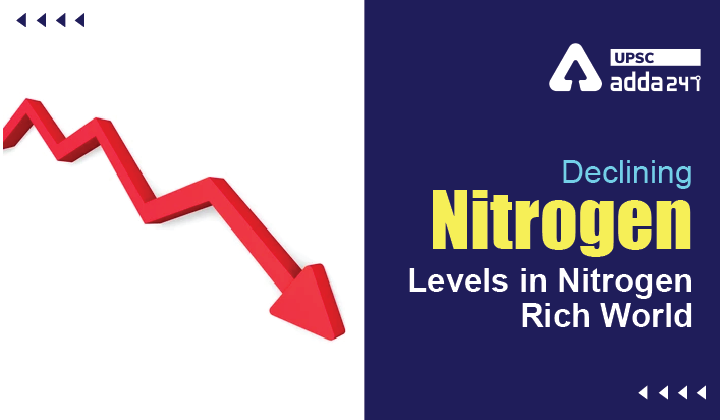Table of Contents
Nitrogen cycle UPSC: Relevance
- GS 3: Conservation, environmental pollution and degradation, environmental impact assessment.
Declining Nitrogen Levels: Context
- According to a recently published report, an imbalance in nitrogen availability has been reported across the globe, thus hurting many aquatic and terrestrial life.
Declining Nitrogen Levels: Key points
- While some places have an excess of nitrogen, others have witnessed a shortage of the element.
- The issue of declining nitrogen availability, however, is not new and it has been on the scientific radar for a long time.
- Nitrogen availability has been shrinking in grasslands in central North America for a hundred years.
- Due to this reason, cattle grazing these areas have had less protein in their diets over time.
- Many forests in North America and Europe have also suffered from nutritional declines for several decades or longer due to the same reason.
- Experts have also said that tropical and boreal forests may be particularly vulnerable.
Reasons of low nitrogen level
- Plants grow quickly when exposed to high carbon dioxide (CO2) concentrations. Thus, their demand for nitrogen also goes up.
- High CO2 levels dilute plant nitrogen, triggering a cascade of effects that lower the availability of nitrogen.
- Other factors include: warming and disturbances, including wildfire.
Impact of low nitrogen level
- Nitrogen is an essential nutrient. Without nitrogen, plants grow slowly and produce smaller flowers and fruits.
- Also, in the absence of nitrogen, the leaves of plants turn yellowish and are less nutritious to insects, birds and animals.
- Plants with low nitrogen levels can also encourage swarming in some species of locusts.
- Low nitrogen availability could limit plants’ ability to capture Carbon dioxide from the atmosphere.
Impact of higher nitrogen production
- Human production of nitrogen is now five times higher than it was 60 years ago.
- Excessive nitrogen accumulates in the streams, inland lakes and coastal bodies of water. It could sometimes result in eutrophication, leading to harmful alsgal blooms, dead zones and fish kills.
- In humans, high levels of nitrogen in the groundwater are linked to intestinal cancers and miscarriages and can be fatal for infants.
Read current affairs for UPSC





 TSPSC Group 1 Question Paper 2024, Downl...
TSPSC Group 1 Question Paper 2024, Downl...
 TSPSC Group 1 Answer key 2024 Out, Downl...
TSPSC Group 1 Answer key 2024 Out, Downl...
 UPSC Prelims 2024 Question Paper, Downlo...
UPSC Prelims 2024 Question Paper, Downlo...





